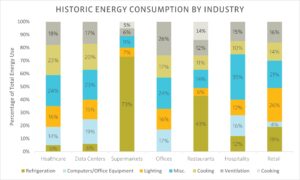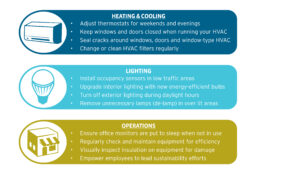Commercial buildings are diverse in both appearance and end use. Buildings range from the tiny dry cleaners on the corner to large data centers in the Columbia River Gorge to “Big Pink” looming above downtown Portland. Commercial energy use is just as varied as the sizes and shapes of the buildings and COVID-19 has changed use and demand across the board. Learn more about how energy is used on a national scale, what that means to you and your business and low- and no-cost ways to help improve your energy use.
As reopening continues across the country, learning more about how businesses like yours use energy is a great place to start if you are considering ways to improve your energy use. It may even provide insights into energy- and cost- saving opportunities.
Energy use by sector
According to a recent study, total energy usage in the commercial sector fell 11% during the pandemic. However, not all commercial buildings were impacted uniformly. Despite an estimated 50% of the U.S. working population working from home, empty office buildings still consumed energy at 40% to 100% of normal operation. According to ENERGY STAR®, restaurants typically use 5-7 times more energy per square foot than other commercial building types. Though many restaurants switched to delivery and take out, their energy costs stayed relatively close to pre-pandemic levels as nearly half of the electricity used by restaurants goes to powering refrigerators and normal business practices—cooking, lighting and ventilation—accounting for the remainder.
On the other end, some building types like supermarkets, hospitals and data centers continued to operate through the shutdown with minimal interruptions. Some even increased operations which resulted in higher energy use. For example, hospitals experienced a 600% increase in energy consumption during the pandemic.
For many businesses, closing their doors did not grant proportional energy savings. Outdated building systems and inefficient technology continued to heat, ventilate and refrigerate at pre-pandemic levels.
For businesses whose operation increased during the pandemic, the challenge is not reducing energy use but optimizing energy use to ensure the increase in business activity does not raise costs and negatively impact the bottom line.
What you can do to start saving
As reopening efforts continue, recognizing your building’s energy footprint should be one item on your agenda. Once you start observing energy use, you can identify simple low and no-cost energy-saving opportunities. For example, you can mitigate inefficiencies in lighting and HVAC systems by turning off equipment when not in use and setting the thermostat back when the building is unoccupied. Dirty HVAC filters cost more to use, overwork the equipment and result in lower indoor air quality. Regularly changing or cleaning HVAC filters during peak cooling or heating season will help prevent these negative effects. Saving energy can help your business run more smoothly and save you money on utility bills and it can be as easy as changing a few simple habits.
Have questions specific to your business? Call 1.866.605.1676 or email existingbuildings@energytrust.org to speak with an Energy Advisor about more ways you can achieve long-term energy savings.



